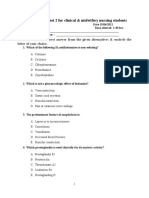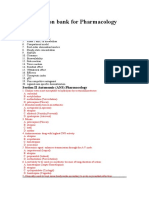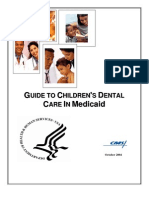Pharm Exam Agian
Pharm Exam Agian
Uploaded by
yalahopaCopyright:
Available Formats
Pharm Exam Agian
Pharm Exam Agian
Uploaded by
yalahopaOriginal Description:
Copyright
Available Formats
Share this document
Did you find this document useful?
Is this content inappropriate?
Copyright:
Available Formats
Pharm Exam Agian
Pharm Exam Agian
Uploaded by
yalahopaCopyright:
Available Formats
DAPH 721 Dr.
Gail Galasko Pharmacology Fall 2002 Test 4 - B
NAME _____________________
Part I - Multiple Choice. Each question is worth two points. 1. To reduce a patient's salivary flow, a dentist has prescribed atropine. As a result of this medication, the patient might experience which of the following side effects? a. b. c. d. e. 2. sedation diarrhea bradycardia blurred vision stomach cramping
Administration of succinylcholine to a patient deficient in serum cholinesterase would most likely result in a. b. c. d. e. convulsions. hypertension. prolonged apnea. acute asthmatic attack. none of the above
3.
Which of the following is a non-depolarizing muscle relaxant? a. b. c. d. e. succinylcholine ipratropium tropicamide atracurium all of the above
4.
Which of the following drugs could be used to treat severe hypertension? a. b. c. d. e. atropine scopolamine botulinis toxin trimethaphan none of the above
5.
Which of the following drugs may cause muscarinic effects such as bradycardia?
a. b. c. d. e. 6.
d-tubocurare succinylcholine vecuronium none of the above (b) and (c)
With an overdose of a cholinergic drug, one would expect to see each of the following signs EXCEPT one. Which one is this EXCEPTION? a. b. c. d. e. sweating urination mydriasis bradycardia copious serous saliva
7.
Atropine is useful in treating poisoning by organophosphate insecticides because a. b. c. d. e. it reactivates inhibited acetylcholinesterase. it stimulates nicotinic receptors. it inhibits normal ganglionic transmission. it blocks actions of acetylcholine at both central and peripheral sites. all of the above
8.
The cause of death from organophosphate "nerve gas" poisoning would probably be a. b. c. d. e. gastrointestinal bleeding. hypertension. respiratory failure. congestive heart failure. cardiac arrhythmia.
9.
A 30-year-old man has been treated with several autonomic drugs. He is now showing signs of drug toxicity. Which of the following signs would distinguish between an overdose of a ganglion blocker verses a muscarinic blocker? a. b. c. d. e. mydriasis tachycardia hypotension blurred vision dry mouth, constipation
10.
In the human eye, echothiophate can cause all of the following EXCEPT a. b. miosis. ciliary spasm.
c. d. e. 11.
reversal of the cycloplegic action of atropine. decrease in the incidence of cataracts. reduction in intraocular pressure.
When a dose-response study of atropine is carried out in young adults, which of the following effects may be observed? a. b. c. d. e. bradycardia tachycardia central nervous system stimulation, e.g., hallucinations central nervous system depression, e.g., sedation all of the above
12.
All of the following may cause cycloplegia (paralysis of accommodation) when used topically in the eye EXCEPT a. b. c. d. e. atropine. physostigmine. tropicamide. homatropine scopolamine.
13.
Potential therapeutic uses of neuromuscular blockers include a. b. c. d. e. diagnosis of myasthenia gravis. control of ventilation during surgery. endotracheal intubation. (b) and (c) are correct. All of the above are correct.
14.
Succinylcholine blocks neuromuscular transmission by a. b. c. d. e. inhibiting cholinesterase. inhibiting the central nervous system. depolarizing the motor endplate of skeletal muscle. inducing formation of cholinesterase at the endplate. blocking release of acetylcholine at the endplate.
15.
Which of the following is an endogenous catecholamine? a. b. c. d. ephedrine amphetamine dopamine isoproterenol
e. 16.
all of the above
Which of the following is/are true for epinephrine? a. b. c. d. e. Given exogenously it acts rapidly. It has bronchodilator and vasoconstrictor properties. It is the drug of choice to treat anaphylaxis. (a) and (c) (a), (b) and (c)
17.
Which of the following effects of epinephrine would be blocked by phentolamine but not by metoprolol? a. b. c. d. e. relaxation of bronchial smooth muscle cardiac stimulation contraction of radial smooth muscle in the iris increase of cAMP in fat relaxation of the uterus
18.
When pupillary dilation, but not cycloplegia, is desired, a good choice is a. b. c. d. e. homatropine. pilocarpine. isoproterenol. tropicamide. phenylephrine.
19.
Stimulation of -adrenergic receptors causes all of the following EXCEPT a. b. c. d. e. decreased peripheral resistance. increased heart rate. increased release of glucose from the liver. mydriasis. bronchodilation.
20.
Which of the following is MOST apt to cause DECREASED release of norepinephrine? a. b. c. d. e. prazosin phentolamine clonidine isoproterenol amphetamine
21.
Phentolamine and tolazoline a. b. c. d. e. are inactive by the oral route. induce vasospasm in large doses. cause tachycardia. cause hypertension. block both alpha and beta receptors.
22.
Which of the following binds covalently to its receptor? a. b. c. d. e. epinephrine phenoxybenzamine propranolol terbutaline amphetamine
23.
Which of the following is a 2-selective drug used in acute asthmatic bronchoconstriction. a. b. c. d. e. epinephrine isoproterenol norepinephrine phenylephrine albuterol
24.
The use of epinephrine for local hemostasis during surgery might result in a. b. c. d. e. hypoglycemia. cardiac arrhythmia. an acute asthmatic attack. a drastic drop in blood pressure. any of the above
25.
Which of the following combinations of agents would be necessary to block the cardiovascular effects produced by the injection of a sympathomimetic drug? a. b. c. d. e. atropine and prazosin atropine and propranolol prazosin and propranolol phenoxybenzamine and curare amphetamine and propranolol
26.
Injection of a pressor dose of norepinephrine may result in a decreased heart rate because of
a. b. c. d. e. 27.
activation of baroreceptor reflexes. direct stimulation of receptors. direct stimulation of 1 receptors. direct stimulation of 2 receptors. direct stimulation of muscarinic receptors.
Adverse effects of -adrenergic blocking agents include a. b. c. d. e. dizziness. postural hypotension. tachycardia. (a) and (b) (a), (b) and (c)
28.
Which of the following drugs will be most likely to increase airway resistance in a patient with pulmonary obstructive disease? a. b. c. d. e. isoproterenol atenolol bitolterol terbutaline nadolol
29.
Which of the following drug(s) is/are are non-selective antagonists? a. b. c. d. e. Propranolol Timolol Metoprolol Atenolol (a) and (b)
30.
Activation of parasympathetic nervous system results in which of the following responses? a. b. c. d. e. an increase in heart rate vasoconstriction bronchoconstriction relaxation of ureters relaxation of GIT
31.
Fill in the blank. What group of drugs cause bradycardia, hypotension and bronchial constriction?
_______________________________
32.
Fill in the blank. What group of drugs cause vasodilation, orthostatic hypotension, tachycardia and lower blood pressure?
________________________________
You might also like
- Nbde Ii - Test Packet II-m (2000-2008)Document35 pagesNbde Ii - Test Packet II-m (2000-2008)yalahopa95% (19)
- Pharmacology MCQ - PDF (A)Document0 pagesPharmacology MCQ - PDF (A)mesfinmulugeta89% (9)
- Questions PharmaDocument176 pagesQuestions Pharmaminakshi boss100% (4)
- Occlusion MCQDocument41 pagesOcclusion MCQAmar Bhochhibhoya75% (32)
- AnsDocument10 pagesAnsMhamad MoussawiNo ratings yet
- Study Questions-Medical Pharmacology - MED 301 - Drugs Used in Coardiovascular Disorders - Prof. Nedret AltıokDocument16 pagesStudy Questions-Medical Pharmacology - MED 301 - Drugs Used in Coardiovascular Disorders - Prof. Nedret Altıokفاعل خيرNo ratings yet
- Daph721 Ex 971029 Exam5Document5 pagesDaph721 Ex 971029 Exam5yalahopa0% (1)
- Final 14 01 2022Document9 pagesFinal 14 01 2022rzg862rjpfNo ratings yet
- CVS Past Paper 2018Document10 pagesCVS Past Paper 2018Bigabwa BernardNo ratings yet
- 1Document12 pages1RAED GhunaimNo ratings yet
- QuestionsDocument61 pagesQuestionsTop MusicNo ratings yet
- QuestionsDocument61 pagesQuestionsTop MusicNo ratings yet
- Version 2Document10 pagesVersion 2rezarko41No ratings yet
- 100 MCQs-3Document19 pages100 MCQs-3hassan qureshiNo ratings yet
- MD Final Exam 2022 With AnswresDocument10 pagesMD Final Exam 2022 With Answresrezarko41No ratings yet
- Pharmacology QuestionsDocument12 pagesPharmacology QuestionsNippu RaaNo ratings yet
- Mohamed Asem Ahmed KassemDocument8 pagesMohamed Asem Ahmed KassemLop LopNo ratings yet
- Pharma QuestionsDocument13 pagesPharma QuestionsSarah Mae Sincero100% (1)
- PCOL CHP 4-6 (Situational Analysis)Document2 pagesPCOL CHP 4-6 (Situational Analysis)Sunshine_Bacla_4275No ratings yet
- Pharm Retake QuestionsDocument16 pagesPharm Retake QuestionsUneke EdwardsNo ratings yet
- PHARMACOLOGY REVISION QuestionsDocument7 pagesPHARMACOLOGY REVISION QuestionsPatrick Ngo'nga ChifwemaNo ratings yet
- 2Document13 pages2RAED GhunaimNo ratings yet
- (Medicalstudyzone - Com) Prometric NeuroDocument145 pages(Medicalstudyzone - Com) Prometric Neuroahmed yahyaNo ratings yet
- # CLINICAL PHARMA FINALS MCQs 2021-1-30Document30 pages# CLINICAL PHARMA FINALS MCQs 2021-1-30Pavan chowdaryNo ratings yet
- Which of The Following H1 Antihistamines Is Non SedatingDocument7 pagesWhich of The Following H1 Antihistamines Is Non SedatingJafer DetamoNo ratings yet
- Pharma PYQsDocument18 pagesPharma PYQspamukinstaNo ratings yet
- Autonomic Practice Questions MEDPHARM 501/801 FALL, 2004Document16 pagesAutonomic Practice Questions MEDPHARM 501/801 FALL, 2004suresh yadavNo ratings yet
- HypertensionDocument16 pagesHypertensionElias IbrahimNo ratings yet
- 01 GRAT - ANS PharmDocument4 pages01 GRAT - ANS PharmjuanNo ratings yet
- اسئله مجمعه من الجروبDocument15 pagesاسئله مجمعه من الجروبمعتز الجعفريNo ratings yet
- Question Bank For Pharmacology - WJP AnsweredDocument55 pagesQuestion Bank For Pharmacology - WJP AnsweredGeorge MoshiNo ratings yet
- Pharmacology MBCHB TEST 3 .2021Document14 pagesPharmacology MBCHB TEST 3 .2021JUSTINA PRINCESS MABUMBA SELENJENo ratings yet
- MecamylanimeDocument15 pagesMecamylanimeNoor HaiderNo ratings yet
- AutonomicDocument10 pagesAutonomicHala AhmadNo ratings yet
- Q6 Cardiovascular PharmacologyDocument4 pagesQ6 Cardiovascular PharmacologyHainey GayleNo ratings yet
- MCQs ANS 2Document7 pagesMCQs ANS 2M Imran Sajid0% (1)
- Final Summer 2022Document33 pagesFinal Summer 2022rzg862rjpfNo ratings yet
- PHARMACOLOGYDocument36 pagesPHARMACOLOGYjanr123456100% (1)
- Study QuestionsDocument5 pagesStudy QuestionsasemNo ratings yet
- Psychiatry 2019 JuneDocument9 pagesPsychiatry 2019 JuneanuchittakattuNo ratings yet
- Pcl 3303 Exams_objectives Marking Scheme-1Document9 pagesPcl 3303 Exams_objectives Marking Scheme-1hauwau028No ratings yet
- pharmacology_test1_2021 answersDocument9 pagespharmacology_test1_2021 answersDavidNo ratings yet
- FINALE QB PHARMA-AnsweredDocument9 pagesFINALE QB PHARMA-AnsweredmaaarrieeemmmNo ratings yet
- Intro To Pharmacology Study GuideDocument93 pagesIntro To Pharmacology Study GuideMichelle Morgan LongstrethNo ratings yet
- 6_cal Record Key Part1Document6 pages6_cal Record Key Part1rishaliniNo ratings yet
- Untitled DocumentDocument4 pagesUntitled DocumentgracesepisomwanzaNo ratings yet
- batch 19 anaesthesia exam_290122083034Document11 pagesbatch 19 anaesthesia exam_290122083034rubaomer.comNo ratings yet
- Heart FailureDocument10 pagesHeart FailureAfiya MohammedNo ratings yet
- Anaesthesia 6Document20 pagesAnaesthesia 6AHAMED SHIFAANNo ratings yet
- Pharmacology Nle 2024Document13 pagesPharmacology Nle 2024nwrenzieNo ratings yet
- PHM Res 302Document25 pagesPHM Res 302Salifyanji SimpambaNo ratings yet
- Old QueDocument6 pagesOld QueMya Phone MohNo ratings yet
- ans mcqsDocument5 pagesans mcqsDesu TeenaNo ratings yet
- Mlyuka QuestionDocument27 pagesMlyuka Questionwww.nathanmengoNo ratings yet
- Rau's Respiratory Care Pharmacology 11th Edition Test Bank by Douglas Gardenhire, IsBN 9780323871556, All 23 Chapters CoveredDocument41 pagesRau's Respiratory Care Pharmacology 11th Edition Test Bank by Douglas Gardenhire, IsBN 9780323871556, All 23 Chapters CoveredMarcus KingNo ratings yet
- Case Studies PharmacologyDocument6 pagesCase Studies PharmacologyZaigham HammadNo ratings yet
- Pharmacology 4R-FDocument57 pagesPharmacology 4R-FelyassahebihpgNo ratings yet
- MCQS ANS 02 SolDocument5 pagesMCQS ANS 02 SolSamir Rekha Mukund Joshi100% (1)
- Ans 2Document5 pagesAns 2haroonst2001No ratings yet
- 2017 Syllabus - MVH Modular Sedation SeriesDocument11 pages2017 Syllabus - MVH Modular Sedation SeriesyalahopaNo ratings yet
- PharmacologyDocument49 pagesPharmacologyRishit P PatelNo ratings yet
- Periodicity DentalGuideDocument52 pagesPeriodicity DentalGuideSalam BataienehNo ratings yet
- Common Lesions CompetencyDocument9 pagesCommon Lesions CompetencyyalahopaNo ratings yet
- 2Document10 pages2yalahopaNo ratings yet
- A Must Print ORTHODocument42 pagesA Must Print ORTHOyalahopa0% (1)
- Oral Midterm 1Document48 pagesOral Midterm 1yalahopa0% (1)
- PharmacologyDocument49 pagesPharmacologyRishit P PatelNo ratings yet
- Antibiotic GuidelineDocument116 pagesAntibiotic GuidelineD'nollas LadysNo ratings yet
- 567AccessOpening StephDocument30 pages567AccessOpening StephyalahopaNo ratings yet
- PharmacologyDocument49 pagesPharmacologyRishit P PatelNo ratings yet
- Quiz SampleDocument3 pagesQuiz Sampleyalahopa100% (1)
- Pedo 721 2001 Final PDFDocument12 pagesPedo 721 2001 Final PDFyalahopaNo ratings yet
- A Must Print ORTHODocument42 pagesA Must Print ORTHOyalahopa0% (1)
- PharmacologyDocument236 pagesPharmacologyyalahopa100% (2)
- NbdeDocument7 pagesNbdeyalahopaNo ratings yet
- Spec Endo SSGDocument68 pagesSpec Endo SSGyalahopaNo ratings yet
- 1 s2.0 S0028390813003195 MainDocument24 pages1 s2.0 S0028390813003195 MainOanaNo ratings yet
- EnvironmentDocument9 pagesEnvironmentrimantasjankusNo ratings yet
- Chapter 14 Notes (Large)Document20 pagesChapter 14 Notes (Large)emarcottesrNo ratings yet
- Sesden Vs BuscopanDocument7 pagesSesden Vs BuscopanCika PasaribuNo ratings yet
- Anti Parkinson DrugsDocument33 pagesAnti Parkinson Drugsraina3546No ratings yet
- Lippincott SummaryDocument132 pagesLippincott SummaryMuhammad HaseebNo ratings yet
- Pgi May 2012 Ebook PDFDocument50 pagesPgi May 2012 Ebook PDFloviNo ratings yet
- Neurotransmitter Function Examples of Malfunctions: Common Neurotransmitters - KEYDocument2 pagesNeurotransmitter Function Examples of Malfunctions: Common Neurotransmitters - KEYidjacobsNo ratings yet
- Local AnesthesiaDocument121 pagesLocal AnesthesiaGabriela Cocieru Motelica100% (2)
- Lecture 2 PDFDocument15 pagesLecture 2 PDFAya MuhannadNo ratings yet
- Physiology All LecturesDocument1,115 pagesPhysiology All LecturesJohnny BravoNo ratings yet
- Veterinary Neuropharmacology VPT 321 Lecture Notes TANUVASDocument101 pagesVeterinary Neuropharmacology VPT 321 Lecture Notes TANUVASSunil89% (18)
- The Autonomic Nervous SystemDocument15 pagesThe Autonomic Nervous SystemAnonymous kQuaT9arl5No ratings yet
- PHARMA Rationale 2017 2018Document141 pagesPHARMA Rationale 2017 2018Remy Martin Guy LesiguesNo ratings yet
- Chemical Control of The Brain and BehaviourDocument30 pagesChemical Control of The Brain and BehaviourSpongeBob SquarePants Fidget ToysNo ratings yet
- Basic Principles of Pharmacology With Dental Hygiene Applications - Lippincott Williams & Wilkins 1 Edition (September 30, 2008)Document362 pagesBasic Principles of Pharmacology With Dental Hygiene Applications - Lippincott Williams & Wilkins 1 Edition (September 30, 2008)DrleoNo ratings yet
- J. Med. Chem. 2003, 46, 2716-2730Document15 pagesJ. Med. Chem. 2003, 46, 2716-2730Slapdragonx100% (1)
- HAAD ExamDocument17 pagesHAAD ExamDaniel Alvarez95% (22)
- M. Pharm SyllabusDocument64 pagesM. Pharm SyllabusNirali DongaNo ratings yet
- BR Bioweapon - How The COVID Virus Was Engineered To Kill and MaimDocument22 pagesBR Bioweapon - How The COVID Virus Was Engineered To Kill and MaimJose Campos100% (2)
- Pharmacology Step 1 For USMLEDocument3 pagesPharmacology Step 1 For USMLEraj_1041100% (1)
- Autonomic Nervous System QuestionsDocument6 pagesAutonomic Nervous System Questions202210034No ratings yet
- Boquecosa Nursing Review ReviewerDocument19 pagesBoquecosa Nursing Review ReviewerElay PedrosoNo ratings yet
- June 2021 (v3) MSDocument22 pagesJune 2021 (v3) MSdavidrmagnoNo ratings yet
- Update Pharma Graf GDocument3 pagesUpdate Pharma Graf GSyamil Azhar100% (1)
- ANS Pharmacology (Intro) - Dr. Agung - 2016Document56 pagesANS Pharmacology (Intro) - Dr. Agung - 2016Erik FebrianaNo ratings yet
- Итоговое 2020 MCQDocument62 pagesИтоговое 2020 MCQmohammad farooque razaa100% (4)
- Advanced Pharmacology - IDocument137 pagesAdvanced Pharmacology - IAdvaita CarvakaNo ratings yet
- Autonomics PharmacologyDocument114 pagesAutonomics Pharmacologybunzalimanyilizu43No ratings yet
- Pex 06 04Document5 pagesPex 06 04Alvin PhenNo ratings yet









































































































